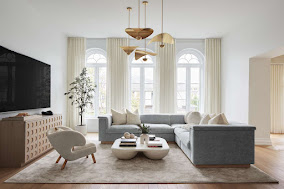 |
| A Modern Style Living Room |
As promised here are 5 more popular interior design styles. Expert decorators write books on each one. Allow me to detail several main traits while you consider your favorites ...

 Click the photos to enlarge. The interior design names follow the images.
Click the photos to enlarge. The interior design names follow the images.6) Modern - According to the Spruce, modern homes "are comfortable and inviting spaces built for relaxed family time and casual entertaining." Living rooms contain ... "ultra-comfortable seating, built-in TV walls, and a focus on natural light." Design elements include natural, earthy, or monochromatic hues along with clean, sleek, and functional furniture. You'll see plywood, concrete, fiberglass, and acrylic paired with steel, stone, wood, bamboo, and leather. Geometric, abstract, retro, and grid patterns are favored.
7) Modern Mid-Century - Simplicity is the mainstay of the MMC style. The furniture has clean lines, soft curves, and functionality. There's no clutter, accessories are minimal, sleek, and serve a purpose. Earthy color palettes dominate. The focus is on natural textures and wood, especially teak, walnut, or oak. The mood of the room is warm, cozy, and calm. Pops of color, geometric shapes, or vintage lamps complete the look. While Frank Lloyd Wright is the most influential architect of the period, George Nelson is the father of MMC design since he created some of its most iconic designs which are still with us today. Onto ...
8) Contemporary - This style evolved from modern design in the 1970s and continues to grow today. I'm posting not 3, but 4 examples of it as it means "now"! Key features include sculptural lights; exposed construction materials such as steel pillars, wooden beams, brick, or concrete; minimalism of form (for example windows replacing walls); and the use of eco-friendly materials such as bamboo, cork, recycled plastics, glass, aluminum, or clay. These new materials gave what is called "a visual edge'' to contemporary design. An additional influence may come from traveling to Asia, South America, or continents not your own. Therefore there may be a mix of cultures in a room. Colors found in nature including (1) stone grey, (2) sandy browns, (3) charcoal black, and (4) cloudy whites are commonly brought into a home with color accents of (5) leafy greens and (6) rich jewel tones. Artwork is often prominent and pleasing without being overly ornate like a featured wall or a standalone statue. Contemporary design also loves open interiors with less division. An example is a "great room," a combined living and dining room that flows out from the kitchen.
9) Glam - This distinct style falls under contemporary. "Glam is an interior design style that's ornate and extravagant, striking the perfect balance between excess and elegance. Using elaborate detailing, high contrast, and luxurious materials, glam style is for those who love a more-is-more approach with a sense of sophistication and plenty of shimmer," quoted (because I like the wording!) from Signature Hardware.
 According to the Spruce, texture and shine unite to create a glam room. Mirrors and mirrored tables give the space a glitzy, upscale feel while silk, velvet, and fur fabrics add texture and interest to the space. You might see crystal chandeliers, sequin lamps, or metallic candlesticks. The main palette color tends to be a sophisticated neutral like white, ivory, cream, grey, or black while pastels and jewel tones bring pizzazz to a room along with crystal, marble, gold or silver, velvet, fur, silk, and spectacular light fixtures.
According to the Spruce, texture and shine unite to create a glam room. Mirrors and mirrored tables give the space a glitzy, upscale feel while silk, velvet, and fur fabrics add texture and interest to the space. You might see crystal chandeliers, sequin lamps, or metallic candlesticks. The main palette color tends to be a sophisticated neutral like white, ivory, cream, grey, or black while pastels and jewel tones bring pizzazz to a room along with crystal, marble, gold or silver, velvet, fur, silk, and spectacular light fixtures.
10) Maximalism - is another design style with a more is more mentality. The look embraces bold uses of color, pattern, and layering to create a space that celebrates excess. Although the style champions an exuberance of colors, patterns, textures, shapes, and objects, it works because it's as intentional and curated as any other interior design type. Think of maximalism as mindful over-the-top playfulness. It avoids clutter, messiness, and neutrals. Bright show-stopping colors are a must. Design elements mix patterns with contrasting themes like animal prints, geometric shapes, and florals. Expect to see chandeliers, statement pieces, ornate accents, or unique wallpaper. Maximalism, well done, shows you the unexpected by skillfully linking unrelated elements together. It's surprisingly warm ... I love it!
 |
| Photo of Maximalism style by Meagan Hopp - NYC Project |
I hope you enjoy this series on interior design styles as much as I do! Some choices in our trilogy (or maybe it'll be tetralogy?), I didn't know a lot about before outlining them. How about you? Learn anything new?
Stay tuned: On Friday I'll publish 5 more Interior Design Styles Part III.
You may also enjoy:

















































